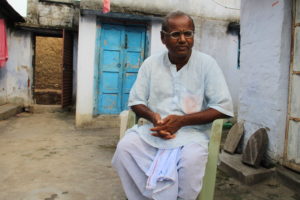
Nirmalendu Mitra Thakur Explains Bake’s Kirtan Recordings, 2021
It is interesting how in my work, different erstwhile unconnected places and people have got connected through the act of shared listening. Nirmalendu Mitra Thakur of Mainadal, whom I first met in 2014 and who has become something of a teacher over the years, has taught me how to listen to Bake’s recordings from not only his village, Mainadal, but also from Kenduli and Mongoldihi. Here is my telephonic conversation with Nirmalendu Mitra Thakur on Bake’s kirtan recordings from Kenduli and Mongoldihi on 22 January 2021.

Nirmalda in the courtyard of his house in 2014
I had sent Bake’s kirtan recordings to Nirmalendu Mitra Thakur to listen and get back to me.
We begin talking on the phone. The conversation begins with Brojobashi’s recordings from 1932, Gourchandrika that Brojobashi sings in ‘madhyam dashkushi’ taal.
We move between the Kenduli kirtan (Badashi and Rati shukho shaare and Jaya Radhe Gobinda) and Brojobashi’s songs and there is a second one (Aaju Shyamo rasho rongiya). Nirmalda sings this song; he recalls learning this song from Gobindagopal Mitra Thakur, singing in chorus at Vrindavan.
Then we talk about Raash Utshob in Mongoldihi, the place of various instruments such as the shinga and shahnai in this music, the recordings Bake made. “Balaram used to play the shinga,’ he tells me. Nirmalda sings bits of song to explain more clearly.
The conversation ends with difficulties faced by kirtaniyas during Covid19 lockdown. Nirmalda explains how hard it has been for those like him who sing kirtan also for a living. Now there is no place to sing, hence no income either.
- Manoharsai from Sumati Devi of Manipur
- Manipur Univisited
- In Search of Nabadwip Brojobashi
- Found Film: Janmashtami and Nandotsav in Mainadal, 1994
- Kirtaniya Seema Acharya Listens to Olly
- Olly Weeks Reads Bake’s Kirtan Notation
- In Mongoldihi, November 2015
- The Niyomsheba Songs, October 2014
- First Time in Mainadal, August 2014
